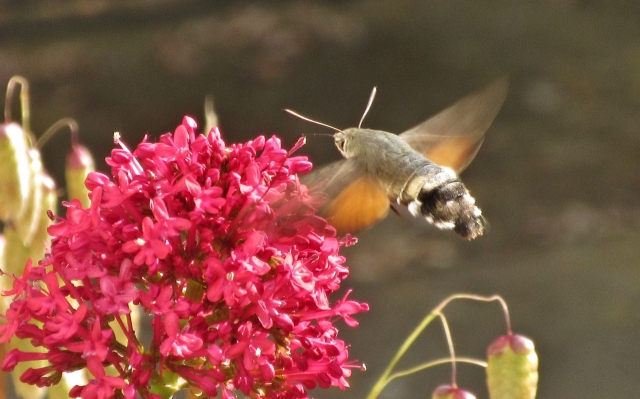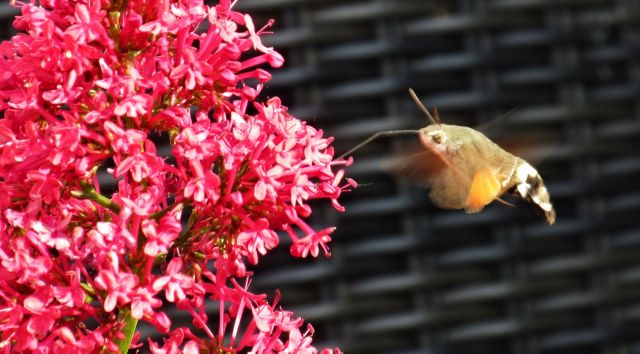I get excited each year when the red valerian flowers open in the garden for no other reason than I know that the Humming-bird Hawk Moths love it and if I look out early morning or evening I have a chance of spotting one.
Humming-bird Hawk Moths, Macroglossum stellatarum, migrate from Africa and are becoming a much more common sight in the UK as the climate warms. 2011 was a very good year for them in the UK and the Butterfly Conservation organisation are again keen to gather statistics for UK sightings for 2015 (see this link: Butterfly Conservation Migrant Watch).
On Monday I spotted my first one for this year, at Wimpole, but it was feeding on Nepeta and was darting around too much for me to get a picture. Fortunately, they are starting to appear in the garden as well and the Valerian (Centranthus ruber) that has self-seeded all round the house is a favourite stop for it. Red Valerian is so densely packed with deep throated flowers that the moth doesn’t move too far between sips. This morning the conditions were excellent (no wind/sun) and so I was able to get a few pictures, including this one of the uncurled proboscis:
The moth does breed regularly in the UK, in July and August, and it’s favourite food plant is Galium (bedstraw) and Rubia (wild madder). Mostly, they don’t make it through UK winters though.

Attention grabbing black and white chequered body and vibrating orange hindwings of the Hummingbird hawk moth
So if you spot one, don’t forget to register the sighting with Butterfly Conservation!



Fantastic! I was trying to photograph loads in the garden this afternoon, but tey are so fast, too fast for me or my camera..and I thought how amazingly like a hummingbird it was..and now, before I even started looking to identify it, up pops your blog! I love that.
That’s great. I was lucky. It is the third time this week I’ve tried to get a picture. In fact, I started out this morning with the camera switched to video so that I would have a chance to grab a single frame later. In the end though, the moth just behaved beautifully.
Great photos! We have yet to see one this year, where you in a sheltered spot at Wimpole?
Cheers Julie, Yes we were working in the walled garden, where it is double protected and baking hot. At home we were just lucky with a still, warm sunny morning.
On how wonderful I have never seen one here. I must keep my eye out for it. Perhaps I should grow some Valerian, I seeded it out because it is so invasive. But if it would bring these wonderful moths to the garden I would give it a home again.
Well, Valerian certainly tries to spread itself around, but it is a big attraction for a lot of insects including, reliably for a number of years, this moth. (I also love it because it reminds me of the seaside). Humming-bird hawk moths are strongly attracted to other flowers that provide a plentiful supply of nectar, such as Honeysuckle, Jasmine, Buddleia, Lilac, Escallonia, Petunia and Phlox. So hopefully these alternatives will work as well.
I remember the first time I saw a hummingbird moth; I was so excited because naturally I thought it was a hummingbird, which in 35 years of gardening I have seen only ONCE (how sad is that?). A little research set me straight though. It was feeding on the flowers of Leptospermum oblonga. Come to think of it, I’ve only seen these moths two or three times since….
I’ve never seen a hummingbird, so you are luckier than me! I bet it looked beautiful on the Leptospermum. The first time I saw these moths was on holiday in France, so they feel special every time I see them here.
Hi and thanks for the Follow re the garden Barn House. Loved this post, we inherited a huge patch of beautiful red valerian here. It’s wonderful to know why we sometimes see this moth!
It is a pleasure to have found your blog. I love grasses and your garden is a delight. I get ridiculously excited about all the hawk moths because they look so exotic, but the hummingbird hawk moth is top of the bunch with its look-alike drinking habits.
Your kind comments are much appreciated! I have been studying the valerian growing over the septic tank with greater interest – if I was more technically adept I’d attach an image here … The best I can do is add one to the gardens summer gallery! Not a chance that I’ll ever capture such a stunning image of this amazing moth, though.